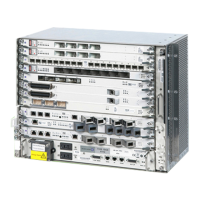3 — ONT and MDU general and interface technical specifications
Alcatel-Lucent 7302 ISAM | 7330 ISAM FTTN | 7360 ISAM FX ONT R04.06.02 November 2013 3-9
3FE 55873 AAAA TCZZA Edition 01
ONT Product Information Guide
Notes
(1)
These items are determined by the country-specific VoIP configuration XML file. The values
specified are for ANSI deployments.
(2)
While the maximum ringing capacity for all ONTs is five REN per POTS line, some ONTs can support
more than one POTS line at a time. For MDUs and business ONTs, the maximum ringing capacity is
three POTS lines with a five REN load ringing simultaneously. For indoor ONTs, the maximum
ringing capacity is two POTS lines with a five REN load ringing simultaneously.
SIP Overview
Voice-over-IP (VoIP) implementations enable users to carry voice traffic over an IP
network. A VoIP system consists of a number of different components: softswitch,
gatekeeper, user agent, signaling gateway and a call manager etc., depending on the
type of signaling-control protocol that is being used. There are a variety of signaling
protocols defined by the standard bodies Internet Engineering Task Force (IETF) and
International Telecommunication Union (ITU), which specify how the user can
setup signaling and bearer paths between the end devices. SIP signaling is based on
a collection of IETF standards.
The ONT is based on an ASIC that provides L2 switching with filtering functions. In
the upstream direction, the ONT assigns traffic to different GEM port IDs based on
L2 fields. In the downstream direction, the ONT performs a cross-connect between
the GEM port ID and the LAN ports. The POTS analog interfaces are part of the
ONT. The VoIP signaling and bearer channels are terminated on the ONT. A VoIP
client manages these terminations and POTS interfaces while performing SIP
signaling with the soft switch.
SIP is a collection of IETF standards (i.e. RFCs). The main RFC for defining SIP is
RFC 3261 which contains the primary “methods” or signaling messages used for
SIP. Additional RFCs are defined that expand on this base to provided more
complete functionality so that a complete set of call features that phone users are
accustomed to can be supported. The connection model for the protocol consists of
a series of signaling transactions with the soft switch which includes the media
stream definitions using SDP (see RFC 2327). The intent of most signaling messages
is to control and define the media stream used to convey the voice data between the
endpoints of a phone call. The media stream or bearer channel has its own protocol,
RTP, which is defined in RFCs 3550 and 3551. In the SIP model, as with all VoIP
models, the bearer channel is connected directly through the IP network, between the
two endpoints, and is not normally connected to the softswitch itself, except for
special cases of application services in support of voice conferencing, voice mail, or
other special softswitch services.
The ONT SIP client is expected to control the analog states of the POTS line, detect
and process dialing, generate tones and Caller ID FSK transmissions, while signaling
with the softswitch to control the phone call, and establish/teardown the RTP bearer
channel associated with the voice path.
VoIP-supporting ONTs have the following general features:
• The ONT supports simultaneous calls on all ports at any point of time.
• The ONT supports up to:
• two simultaneous 3-way Calls on a 2-port ONT
• three simultaneous 3-way Calls on a 4-port ONT
• six simultaneous 3-way Calls on an 8-port ONT
• The ONT supports a single VoIP client per ONT.

